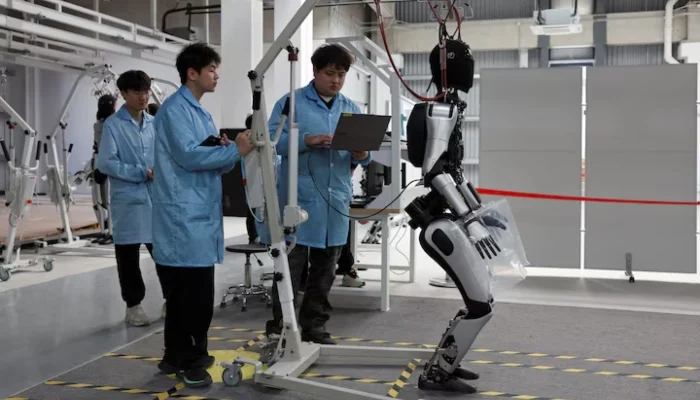In a sprawling warehouse in a Shanghai suburb, dozens of humanoid robots are being operated to repeatedly perform tasks such as folding a T-shirt, making a sandwich, and opening doors.
Operating 17 hours daily, the facility’s objective is to generate vast amounts of data. This data is utilized by its owner, Chinese humanoid startup AgiBot, to train robots that the company hopes will become commonplace and transform how humans live, work, and engage in leisure activities.
“Just imagine that one day in our own robot factory, our robots are assembling themselves,” envisioned Yao Maoqing, a partner at AgiBot.
The significance of humanoid robots to Beijing, as it seeks solutions to critical issues including trade tensions with the United States, a declining population, and slowing economic growth, was highlighted when Chinese President Xi Jinping inspected AgiBot’s robots in Shanghai last month. During the visit, Xi playfully suggested that perhaps the machines could even play on a football team.
Another domestic developer of humanoid robots, Unitree, also participated in a meeting hosted by Xi for private enterprises earlier this year, where he urged them to contribute to China’s economy.
As the US negotiates with China over tariffs previously imposed by President Donald Trump aimed at revitalizing US manufacturing jobs, Beijing is pursuing a new industrial revolution where numerous factory tasks would be executed by humanoid robots.
In recent years, Chinese humanoid robots have demonstrated increasingly sophisticated agility, including performing somersaults, running a half-marathon, and even playing football, as Xi mused.
However, Reuters is now reporting for the first time specific details regarding how China’s advancements in artificial intelligence, partly fueled by the success of domestic firms like DeepSeek and substantial government support, are enabling humanoid developers to integrate the robots’ already impressive hardware with the necessary software to make them economically viable.
Reuters spoke with over a dozen individuals, including Chinese humanoid manufacturers, investors, customers, and analysts. These sources described how breakthroughs in developing robot “brains” will allow these metallic machines to transition from mere novelties to productive and self-learning workers capable of revolutionizing the world’s leading manufacturing power.
Sources indicated that China intends to establish its dominance by focusing on data training and the sophistication of its AI models, with some suggesting that DeepSeek’s capabilities have been a significant asset.
DeepSeek and the Chinese government did not respond to requests for comment regarding their roles in the development of humanoid robots.
The successful and widespread deployment of these robots in factory settings would enable China to sustain economic growth and maintain its manufacturing superiority, positioning this field as an area of competition with the US.
Less certain is how Beijing would address the potential displacement of factory workers. State media has suggested that, similar to previous industrial revolutions, long-term job creation would outweigh short-term job losses.
Chinese authorities are providing substantial subsidies to humanoid firms. Official announcements reveal that over $20 billion has been allocated to the sector in the past year, and Beijing is establishing a one trillion yuan ($137 billion) fund to support startups in areas such as AI and robotics.



